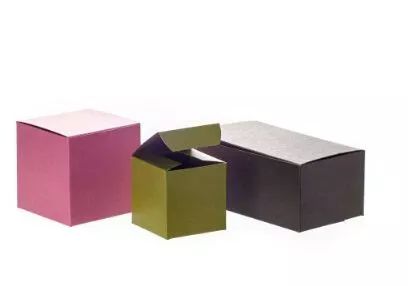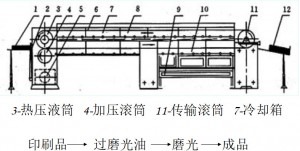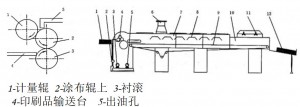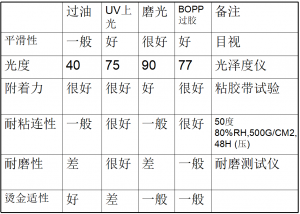The color box is generally made of several colors. The color box post-printing process highlights the overall appearance and color of the goods, and gives consumers a strong visual sense. It has been widely used in medicine, cosmetics and other industries and product packaging and other industries. This article is organized by Shanghai Rainbow package to share the relevant content of the color box post-printing process and common problems.
Color box refers to the folding paper box and micro corrugated paper box made of cardboard and micro corrugated cardboard. It is generally used as a medium packaging method, between the inner packaging and the outer packaging.
01 Post-press process
The post-printing process of color box includes bronzing, oiling, UV varnish, polishing, film covering concave-convex, die-cutting and other processes
02 Over-oil
Process principle
The metering roll is oriented and rotates at a constant speed, and the rotation direction is opposite to that of the coating roll; In this way, the coating layer on the surface of the coating roller is uniform, the printed matter surface is in contact with the coating roller axis surface, and the coating is evenly coated under the effect of the coating viscosity and the roller group pressure.
Type and drying method
According to the type of oil, it can be divided into the following types:
1) Overwater oil
2) Over-gloss oil
3) Superplastic oil
4) Overpolish oil
Oil drying method: infrared drying
Note: The double-sided oiled products must be placed vertically and dried before they can be received. Because the double-sided oiled products are easy to stick
technical requirement
In addition to its colorless, lustrous, fast drying, chemical resistance and other characteristics, glazing oil must also have the following properties:
1) The film has high transparency and no discoloration. The picture and text will not change color after drying. Moreover, it should not be discolored or yellowed due to exposure to the sun or use for a long time.
2) The film has certain wear resistance.
3) It has certain flexibility. The bright film formed by any kind of varnish on the surface of the printed matter must maintain good elasticity to adapt to the flexibility of the paper or paperboard, and will not be damaged, cracked or peeled off.
4) The film has good environmental resistance. It is not allowed to change the performance due to contact with weak acid or weak base in the environment.
5) It has certain adhesion to the surface of printed matter. Due to the influence of the integral density value of the surface image and text ink layer, the surface adhesion of the printed matter is greatly reduced. In order to prevent the dry film from cracking and peeling in use after drying, it is required that the film has strong adhesion, and has certain adhesion to the ink and various auxiliary materials for inking.
6) Good leveling and smooth film surface. The surface absorbency, smoothness and wettability of printed matter vary greatly. In order to make the glossy coating form a smooth film on different product surfaces, it is required that the glossy oil has a good leveling property and the film surface is smooth after film formation.
7) It is required to have wide adaptability for post-press processing. Such as gilding and screen printing.
influence factor
1) Paper performance
The influence of paper on the oil quality is mainly reflected in the smoothness of the paper. The paper with high smoothness has a remarkable effect after being oiled, while the paper with low smoothness has a poor oil passing effect, because the polishing oil is absorbed by the paper with rough surface. To solve this problem, two times of oil are needed
2) Temperature
The oil passing temperature is 18-20 ℃, and the oil passing effect is the best. The oil is easy to solidify in winter, and the oil on the surface of the product is uneven after oil passing
3) Influence of printing ink on glazing quality
The ink used for products that need to be oiled after printing must be solvent resistant and heat resistant, Otherwise, the printed matter will change color or produce wrinkled skin. Therefore, the following points should be paid attention to when selecting the oiled product:
Must select alcohol-resistant, ester solvent, acid-alkali resistant ink
It is necessary to use durable and good gloss ink
Ink with good adhesion to paper must be selected
4) Influence of printing crystallization on polishing quality
The crystallization phenomenon of printed matter is mainly due to the same reasons as the printing matter has been placed for too long, the printing ink area is too large, and the drying oil is added too much. The ink film has crystallization phenomenon on the paper surface. The crystallization phenomenon will make the oil not coated or produce “spots” and “spots”
FAQ analysis
Poor brightness (e.g. PDQ color paper proofing – Weida high gray background white)
reason:
1) The seal has poor paper quality, rough surface and strong absorption
2) Poor coating quality and low film gloss
3) The coating concentration is low, the coating amount is insufficient, and the coating is too thin
4) The drying temperature is low, and the solvent volatilization speed is slow
terms of settlement:
1) When the paper is poor, apply the polish primer first, and then polish after drying
2) Increase the coating concentration and appropriately increase the coating amount
3) Increase the drying temperature and accelerate the volatilization of coating solvent
4) Replace paint
Uneven oil passing and poor local plastic absorption effect
reason:
1) The plastic absorption oil and Tianna are not evenly mixed during dilution
2) Too thin oil
3) Blister oil has too high viscosity and poor leveling
4) Poor plastic absorption effect of plastic absorption oil
resolvent:
1) Dilute quantitatively and stir evenly
2) Quantitative oiling
3) Dilute with Tianna water, and different oils have different proportions
4) Change oil
03 UV varnish
definition
UV varnish is a transparent coating, also known as UV varnish. Its function is to spray or roll coating on the surface of the substrate, and then turn it from liquid to solid through the irradiation of UV lamp, so as to achieve surface hardening. It has the function of scratch resistance and scratch resistance, and the surface looks bright, beautiful and smooth.
FAQ analysis
Poor gloss and brightness
main cause:
1) The viscosity of UV oil is too small and the coating is too thin
2) Excessive dilution of non-reactive solvents such as ethanol
3) Uneven coating
4) The paper is too absorbent
5) The lamination of the gluing anilox roll is too fine, and the oil supply is insufficient
Solution: properly increase the viscosity and coating amount of UV varnish according to the different conditions of the paper: a layer of primer can be coated on the paper with strong absorption.
Poor drying, incomplete curing and sticky surface
main cause:
1) Insufficient ultraviolet light intensity
2) UV lamp tube aging, light intensity weakening
3) UV varnish storage time is too long
4) Too much diluent not participating in the reaction
5) Machine speed is too fast
Solution: When the curing speed is less than 0.5s, the power of the high-pressure mercury lamp should be generally not less than 120W/cm; The lamp tube should be replaced in time. If necessary, add a certain amount of UV varnish curing accelerator to accelerate drying.
The UV varnish on the surface of the printed matter can not be applied, and the printing is blossoming
main cause:
1) The viscosity of UV varnish is too small, and the coating is too thin
2) Ink middle note ink oil or dry oil content is too high
3) The ink surface has crystallized
4) Excessive anti-sticking material (silicone oil) on the ink surface
5) The screen wire of the gluing anilox roller is too thin
6) Problems in construction technology (technicians are not skilled)
Solution: For products requiring UV glazing, corresponding measures should be taken during printing to create certain conditions: UV varnish can be appropriately thicker, and the primer or special varnish formula should be used when necessary.
UV varnish coating is uneven, with stripes and orange peel
main cause:
1) UV varnish viscosity is too high
2) The screen wire of the gluing anilox roller is too thick (the coating amount is too large) and the surface is not smooth
3) Uneven coating pressure
4) Poor leveling of UV varnish
Solution: reduce the viscosity of varnish and reduce the amount of coating; Adjust the pressure evenly; The coating roller shall be polished; Add a bright leveling agent.
UV varnish has poor adhesion
main cause:
1) Printing ink surface crystallization
2) Improper auxiliaries in printing ink
3) UV varnish itself has insufficient adhesion
4) Inappropriate UV curing conditions
Solution: The printing process should consider the glazing conditions in advance; Coat the printed product with primer to enhance adhesion.
UV varnish thickens and has gel phenomenon
main cause:
1) UV varnish storage time is too long
2) UV varnish is not completely stored in dark
3) UV varnish storage temperature is on the high side
Solution: pay attention to the effective use period of UV varnish and store it strictly in dark. The storage temperature should be 5~25 ℃.
Large residual odor
main cause:
1) UV varnish curing is not complete
2) Insufficient ultraviolet light or aging UV lamp
3) UV varnish has poor anti-oxygen interference ability
4) Excessive addition of non-reactive diluent in UV varnish.
Solution: UV varnish curing must be complete, and ventilation should be strengthened. If necessary, change the varnish type.
04 polish summary
The printed matter is fed into the light band between the heating roller and the pressure roller by the paper feeding table. Under the action of heat and pressure, the coating layer is attached to the light band to be calendered.
influence factor

1) Coating amount of polishing oil
Too little coating, poor smoothness after drying and polishing, too much coating, increased cost, slow drying lead to paper embrittlement, and the printing surface is easy to crack when polishing
2) Polishing temperature
If the temperature is too high, the deformation will increase, the temperature is too low, and the polishing smoothness will be low. According to industry experience, 115-120 ℃ is the better polishing temperature
3) Burnish pressure
The printing surface is easy to crack and difficult to peel when the pressure is too large, and the smoothness after polishing is poor when the pressure is too small, and the pressure is controlled at 150~180kg/m2.
4) Polishing speed (curing time)
Short curing time, poor polishing smoothness and poor adhesion strength of paint to ink. The quality of the upper layer increases with the increase of curing time, and does not increase after 6-10 m/min.
5) Stainless steel electroplated polishing belt
Stainless steel is called plating polishing belt, which is the core device of polishing process. The smoothness and brightness of the light belt determines the mirror gloss effect and product quality of the coating.
3. FAQ
The polished film surface is streaked and flowered
reason:
1) Polishing oil has high viscosity and thick coating
2) Polishing oil has poor leveling and uneven coating
3) The surface of printed matter is dusty
4) The polishing temperature is too low to soften the polishing oil
5) The polishing pressure is too low
terms of settlement:
1) The printing ink must be fully dry before polishing
2) Properly reduce the viscosity of polishing oil and improve the leveling property (plus Tianna water)
3) Properly increase the polishing temperature and pressure
Paper breaks after printing is polished
reason:
1) The high polishing temperature reduces the water content of the printed matter and makes the paper fiber brittle;
2) High polishing pressure makes the flexibility and extensibility of paper worse;
3) Polishing oil has poor flexibility;
4) The processing conditions after polishing are not suitable.
resolvent:
1) Reduce the temperature and pressure properly under the condition of meeting the polishing quality;
2) The brittle paper should not be processed immediately after polishing, and effective measures should be taken to change the water content of the printed matter.
3) If the fracture phenomenon is serious, it can be solved by water overflow on the back.
05 Film covering
summary
Film covering is the process of covering plastic film on the surface of printed matter and using adhesive to heat and press it together
The coating process is divided into: namely, coating and precoating
At present, the most commonly used is instant coating in China.
Instant coating film can be divided into oil-based film coating and water-based film coating according to the type of glue
Structural diagram of instant coating film machine.
influence factor
1) The printing material has a great influence on the quality of film covering
The surface is clean. The film covering effect of materials with uniform thickness and high bending strength is ideal
2) The influence of ink on the quality of film coating is very obvious
The thick ink layer of the printed matter or the large area of the printed image and text will cause the ink to close the pores of the fiber, hinder the penetration and diffusion of the adhesive, and make it difficult for the printed matter to adhere to the plastic film, which is prone to blistering.
The ink is coated before it is completely dry. The solvent with high boiling point contained in the ink is easy to expand and elongate the film. After the film is coated, the product will blister and take off the film.
3) Printing process affects film covering quality
The products printed with ordinary gold and silver ink are not suitable for film covering, because the metal powder is easily separated from the ink during the drying process, and the separated metal powder will form a barrier between the ink layer and the adhesive, affecting the effective combination of the two. This product will blister after being placed for a period of time
4) Influence of ambient temperature and humidity
Changes in the moisture content of printed matter (moisture absorption, dehydration) mostly occur at the edge of the product during hot pressing and lamination, which are not easy to form good adhesion with the film, easy to produce wrinkles, and affect the smooth production of the product.
Material requirements
The higher the transparency of the film, the better it is to ensure the best clarity of the covered print
It has good light resistance and does not change color under the action of long time light
To contact with solvents, adhesives, inks and other chemicals, it should have good chemical stability
No white spots, wrinkles, pinholes
The surface energy shall meet the processing requirements of the next process, and the surface energy shall be greater than 38 dynes if it needs to be bronzed
Common films include PET and BOPP films
FAQ analysis
Product curl after slitting
1) The film tension is too large, causing the film to stretch and deform. The film tension device can be adjusted
2) Large winding tension makes the film and paper deform at the same time. Adjust the winding tension device
3) The humidity of the production environment is high. The temperature and humidity of the production workshop should be controlled at 60%
4) The drying time is short. It is required to leave for 4 hours before cutting
Comparison of paper surface processing performance.
06 Prenatal test
Relevant test items of color box products:
1) Simulated transportation test
Abrasion test
Blasting force test
Drop Test
2) Simulated environment test
Aging test
Hot and cold test and cycle test
3) Post-process simulation test
If the customer requires to comply with the customer’s standards, if the customer does not require to comply with the company’s standards, the relevant tests must be done to ensure the product quality
Shanghai rainbow industrial co.,ltd provides one-stop solution for cosmetic packaging.If you like our products, you can contact us,
Website:
www.rainbow-pkg.com
Email: Bobby@rainbow-pkg.com
WhatsApp: +008615921375189
Post time: Feb-15-2023




